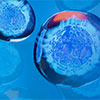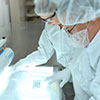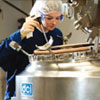Bioss
Numéro de catalogue:
(BOSSBS-6540R-A647)
Fournisseur:
Bioss
Description:
In cooperation with other chaperones, Hsp70s stabilize preexistent proteins against aggregation and mediate the folding of newly translated polypeptides in the cytosol as well as within organelles. These chaperones participate in all these processes through their ability to recognize nonnative conformations of other proteins. They bind extended peptide segments with a net hydrophobic character exposed by polypeptides during translation and membrane translocation, or following stress-induced damage. Sequence similarities Belongs to the heat shock protein 70 family.
UOM:
1 * 100 µl
Numéro de catalogue:
(BOSSBS-6540R-CY3)
Fournisseur:
Bioss
Description:
In cooperation with other chaperones, Hsp70s stabilize preexistent proteins against aggregation and mediate the folding of newly translated polypeptides in the cytosol as well as within organelles. These chaperones participate in all these processes through their ability to recognize nonnative conformations of other proteins. They bind extended peptide segments with a net hydrophobic character exposed by polypeptides during translation and membrane translocation, or following stress-induced damage. Sequence similarities Belongs to the heat shock protein 70 family.
UOM:
1 * 100 µl
Numéro de catalogue:
(BOSSBS-13743R-A350)
Fournisseur:
Bioss
Description:
The catenins are ubiquitously expressed, cytoplasmic proteins that associate with E-cadherin at cellular junctions. Catenin/cadherin complexes play an important role in mediating cellular adhesion. alpha T-catenin, also referred to as VR22, is a 895-amino acid protein that is most abundantally expressed in cardiomyocytes and in the peritubular myoid cells of the testis. alpha T-catenin binds to alpha E-catenin as well as to beta-catenin, and it functions to inhibit Wnt signaling. CTNNA3, the gene that encodes for alpha-T-catenin, is located on chromosome 10, and mutations in this gene show a strong correlation to late-onset Alzheimer's disease (LOAD) as well as to dilated cardiomyopathy.
UOM:
1 * 100 µl
Numéro de catalogue:
(BOSSBS-6540R-CY7)
Fournisseur:
Bioss
Description:
In cooperation with other chaperones, Hsp70s stabilize preexistent proteins against aggregation and mediate the folding of newly translated polypeptides in the cytosol as well as within organelles. These chaperones participate in all these processes through their ability to recognize nonnative conformations of other proteins. They bind extended peptide segments with a net hydrophobic character exposed by polypeptides during translation and membrane translocation, or following stress-induced damage. Sequence similarities Belongs to the heat shock protein 70 family.
UOM:
1 * 100 µl
Numéro de catalogue:
(BOSSBS-2542R-CY3)
Fournisseur:
Bioss
Description:
This gene encodes a member of the C-type lectin/C-type lectin-like domain (CTL/CTLD) superfamily. Members of this family share a common protein fold and have diverse functions, such as cell adhesion, cell-cell signalling, glycoprotein turnover, and roles in inflammation and immune response. The encoded protein may play a role in regulating dendritic cell function. Alternative splice variants have been described but their biological nature has not been determined. This gene is closely linked to other CTL/CTLD superfamily members on chromosome 12p13 in the natural killer gene complex region. [provided by RefSeq]
UOM:
1 * 100 µl
Numéro de catalogue:
(BOSSBS-6539R-FITC)
Fournisseur:
Bioss
Description:
Sequence-specific transcription factor which is part of a developmental regulatory system that provides cells with specific positional identities on the anterior-posterior axis.
UOM:
1 * 100 µl
Numéro de catalogue:
(BOSSBS-6538R-HRP)
Fournisseur:
Bioss
Description:
Sequence-specific transcription factor which is part of a developmental regulatory system that provides cells with specific positional identities on the anterior-posterior axis.
UOM:
1 * 100 µl
Numéro de catalogue:
(BOSSBS-6538R-A750)
Fournisseur:
Bioss
Description:
Sequence-specific transcription factor which is part of a developmental regulatory system that provides cells with specific positional identities on the anterior-posterior axis.
UOM:
1 * 100 µl
Numéro de catalogue:
(BOSSBS-10058R-HRP)
Fournisseur:
Bioss
Description:
Endopeptidase that degrades various components of the extracellular matrix, such as aggrecan and cartilage oligomeric matrix protein (comp), during development, haemostasis and pathological conditions (arthritic disease). May also play a role in neovascularization or angiogenesis. Hydrolyzes collagen type IV, laminin, nidogen, nascin-C isoform, fibronectin, and type I gelatin.
UOM:
1 * 100 µl
Numéro de catalogue:
(BOSSBS-1499R-A647)
Fournisseur:
Bioss
Description:
Ubiquitin-like protein that can be covalently attached to proteins as a monomer or a lysine-linked polymer. Covalent attachment via an isopeptide bond to its substrates requires prior activation by the E1 complex SAE1-SAE2 and linkage to the E2 enzyme UBE2I, and can be promoted by E3 ligases such as PIAS1-4, RANBP2 or CBX4. This post-translational modification on lysine residues of proteins plays a crucial role in a number of cellular processes such as nuclear transport, DNA replication and repair, mitosis and signal transduction. Involved for instance in targeting RANGAP1 to the nuclear pore complex protein RANBP2. Polymeric SUMO1 chains are also susceptible to polyubiquitination which functions as a signal for proteasomal degradation of modified proteins. May also regulate a network of genes involved in palate development.
UOM:
1 * 100 µl
Numéro de catalogue:
(BOSSBS-3073R-A488)
Fournisseur:
Bioss
Description:
Histones play a critical role in transcriptional regulation, cell cycle progression, and developmental events. Histone acetylation/deacetylation alters chromosome structure and affects transcription factor access to DNA. The protein encoded by this gene belongs to the class II histone deacetylase/acuc/apha family. It possesses histone deacetylase activity and represses transcription when tethered to a promoter. It coimmunoprecipitates only with HDAC3 family member and might form multicomplex proteins. It also interacts with myocyte enhancer factor-2 (MEF2) proteins, resulting in repression of MEF2-dependent genes. This gene is thought to be associated with colon cancer. Two transcript variants encoding different isoforms have been found for this gene. [provided by RefSeq].
UOM:
1 * 100 µl
Numéro de catalogue:
(BOSSBS-2835R-CY3)
Fournisseur:
Bioss
Description:
The ankyrin repeat and SOCS box containing (ASB) protein family is comprised of members which each contain "SOCS boxes" but differ from other families of protein in the motifs they contain upstream of the SOCS box. SOCS boxes are carboxy terminal regions of homology found in the suppressor of cytokine signaling family of proteins. The box region is thought to be the point of interaction between SOCS proteins and E3 ubiquitin ligases. The SOCS box serves to couple suppressor of cytokine signalling (SOCS) proteins and their binding partners with the elongin B and C complex, possibly targeting them for degradation. The gene is induced by all trans retinoic acid. In myeloid leukemia cells, the expression of this encoded protein has been shown to induce growth inhibition and chromatin condensation. Multiple alternatively spliced transcript variants have been described for this gene but their full length sequences are not known.
UOM:
1 * 100 µl
Numéro de catalogue:
(BOSSBS-2812R-FITC)
Fournisseur:
Bioss
Description:
Largest component and core scaffold of the TFIID basal transcription factor complex. Contains novel N- and C-terminal Ser/Thr kinase domains which can autophosphorylate or transphosphorylate other transcription factors. Phosphorylates TP53 on 'Thr-55' which leads to MDM2-mediated degradation of TP53. Phosphorylates GTF2A1 and GTF2F1 on Ser residues. Possesses DNA-binding activity. Essential for progression of the G1 phase of the cell cycle.
UOM:
1 * 100 µl
Numéro de catalogue:
(BOSSBS-2812R-A350)
Fournisseur:
Bioss
Description:
Largest component and core scaffold of the TFIID basal transcription factor complex. Contains novel N- and C-terminal Ser/Thr kinase domains which can autophosphorylate or transphosphorylate other transcription factors. Phosphorylates TP53 on 'Thr-55' which leads to MDM2-mediated degradation of TP53. Phosphorylates GTF2A1 and GTF2F1 on Ser residues. Possesses DNA-binding activity. Essential for progression of the G1 phase of the cell cycle.
UOM:
1 * 100 µl
Numéro de catalogue:
(BOSSBS-1499R-HRP)
Fournisseur:
Bioss
Description:
Ubiquitin-like protein that can be covalently attached to proteins as a monomer or a lysine-linked polymer. Covalent attachment via an isopeptide bond to its substrates requires prior activation by the E1 complex SAE1-SAE2 and linkage to the E2 enzyme UBE2I, and can be promoted by E3 ligases such as PIAS1-4, RANBP2 or CBX4. This post-translational modification on lysine residues of proteins plays a crucial role in a number of cellular processes such as nuclear transport, DNA replication and repair, mitosis and signal transduction. Involved for instance in targeting RANGAP1 to the nuclear pore complex protein RANBP2. Polymeric SUMO1 chains are also susceptible to polyubiquitination which functions as a signal for proteasomal degradation of modified proteins. May also regulate a network of genes involved in palate development.
UOM:
1 * 100 µl
Numéro de catalogue:
(BOSSBS-3073R-HRP)
Fournisseur:
Bioss
Description:
Histones play a critical role in transcriptional regulation, cell cycle progression, and developmental events. Histone acetylation/deacetylation alters chromosome structure and affects transcription factor access to DNA. The protein encoded by this gene belongs to the class II histone deacetylase/acuc/apha family. It possesses histone deacetylase activity and represses transcription when tethered to a promoter. It coimmunoprecipitates only with HDAC3 family member and might form multicomplex proteins. It also interacts with myocyte enhancer factor-2 (MEF2) proteins, resulting in repression of MEF2-dependent genes. This gene is thought to be associated with colon cancer. Two transcript variants encoding different isoforms have been found for this gene. [provided by RefSeq].
UOM:
1 * 100 µl
Appel de prix
Le stock de cet article est limité mais peut être disponible dans un entrepôt proche de vous. Merci de vous assurer que vous êtes connecté sur le site afin que le stock disponible soit affiché. Si l'
Le stock de cet article est limité mais peut être disponible dans un entrepôt proche de vous. Merci de vous assurer que vous êtes connecté sur le site afin que le stock disponible soit affiché. Si l'
Ces articles ne peuvent être ajoutés au Panier. Veuillez contacter votre service client ou envoyer un e-mail à vwr.be@vwr.com
Une documentation supplémentaire peut être nécessaire pour l'achat de cet article. Un représentant de VWR vous contactera si nécessaire.
Ce produit a été bloqué par votre organisation. Contacter votre service d'achat pour plus d'informations.
Le produit original n'est plus disponible. Le remplacement représenté est disponible
Les produits marqués de ce symbole ne seront bientôt plus disponibles - vente jusqu'à épuisement de stock. Des alternatives peuvent être disponibles en recherchant le code article VWR indiqué ci-dessus. Si vous avez besoin d'une assistance supplémentaire, veuillez contacter notre Service Clientèle au 016 385 011.
|
|||||||||||||||
















































